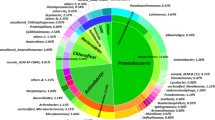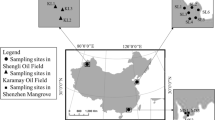Abstract
The aim of this study was to survey the response of the microbial community to crude oil and the diversity of alkane hydroxylase (alkB) genes in soil samples from the Qinghai-Tibet Plateau (QTP). The enrichment cultures and clone libraries were used. Finally, 53 isolates and 94 alkB sequences were obtained from 10 pristine soil samples after enrichment at 10 °C with crude oil as sole carbon source. The isolates fell into the phyla Proteobacteria, Actinobacteria, and Bacteroidetes, with the dominance of Pseudomonas and Acinetobacter. The composition of degraders was different from polar habitats where Acinetobacter sp. is not a predominant responder of alkane degradative microbial communities. Phylogenetic analysis showed that the alkB genes from isolates and enrichment communities formed eight clusters and mainly related with alkB genes of Pseudomonas, Rhodococcus, and Acinetobacter. The alkB gene diversity in the QTP was lower than marine environments and polar soil samples. In particular, a total of 10 isolates exhibiting vigorous growth with crude oil could detect no crude oil degradation-related gene sequences, such as alkB, P450, almA, ndoB, and xylE genes. The Shannon-Wiener index of the alkB clone libraries from the QTP ranged from 1.00 to 2.24 which is similar with polar pristine soil samples but lower than that of contaminated soils. These results indicated that the Pseudomonas, Acinetobacter, and Rhodococcus genera are the candidate for in situ bioremediation, and the environment of QTP may be still relatively uncontaminated by crude oil.





Similar content being viewed by others
References
Crisafi, F., Giuliano, L., Yakimov, M. M., Azzaro, M., & Denaro, R. (2016). Isolation and degradation potential of a cold-adapted oil/PAH-degrading marine bacterial consortium from Kongsfjorden (Arctic region). Rendiconti Lincei, 27(S1), 261–270. doi:10.1007/s12210-016-0550-6.
Deppe, U., Richnow, H.-H., Michaelis, W., & Antranikian, G. (2005). Degradation of crude oil by an arctic microbial consortium. Extremophiles, 9(6), 461–470. doi:10.1007/s00792-005-0463-2.
Ferrera-Rodriguez, O., Greer, C. W., Juck, D., Consaul, L. L., Martinez-Romero, E., & Whyte, L. G. (2013). Hydrocarbon-degrading potential of microbial communities from Arctic plants. Journal of Applied Microbiology, 114(1), 71–83. doi:10.1111/jam.12020.
Jin, H. J., Yu, Q. H., Wang, S. L., & Lü, L. Z. (2008). Changes in permafrost environments along the Qinghai–Tibet engineering corridor induced by anthropogenic activities and climate warming. Cold Regions Science and Technology, 53(3), 317–333. doi:10.1016/j.coldregions.2007.07.005.
Jukes, T. H., & Cantor, C. R. (1969). Evolution of protein molecules. Mammalian Protein Metabolism, 3(21), 132.
Jurelevicius, D., Alvarez, V. M., Peixoto, R., Rosado, A. S., & Seldin, L. (2013). The use of a combination of alkB primers to better characterize the distribution of alkane-degrading bacteria. PloS One, 8(6), e66565. doi:10.1371/journal.pone.0066565.t001.
Kim, O. S., Cho, Y. J., Lee, K., Yoon, S. H., Kim, M., Na, H., et al. (2012). Introducing EzTaxon-e: a prokaryotic 16S rRNA gene sequence database with phylotypes that represent uncultured species. International Journal of Systematic and Evolutionary Microbiology, 62(Pt 3), 716–721. doi:10.1099/ijs.0.038075-0.
Kloos, K., Munch, J. C., & Schloter, M. (2006). A new method for the detection of alkane-monooxygenase homologous genes (alkB) in soils based on PCR-hybridization. Journal of Microbiological Methods, 66(3), 486–496. doi:10.1016/j.mimet.2006.01.014.
Kuhn, E., Bellicanta, G. S., & Pellizari, V. H. (2009). New alk genes detected in Antarctic marine sediments. Environmental Microbiology, 11(3), 669–673. doi:10.1111/j.1462-2920.2008.01843.x.
Lane, D. J. (1991). 16S/23S rRNA sequencing. Nucleic acid techniques in bacterial systematics, 125–175.
Li, H., Wang, X.-L., Mu, B.-Z., Gu, J.-D., Liu, Y.-D., Lin, K.-F., et al. (2013). Molecular detection, quantification and distribution of alkane-degrading bacteria in production water from low temperature oilfields. International Biodeterioration & Biodegradation, 76, 49–57. doi:10.1016/j.ibiod.2012.06.007.
Liu, C., Wang, W., Wu, Y., Zhou, Z., Lai, Q., & Shao, Z. (2011). Multiple alkane hydroxylase systems in a marine alkane degrader, Alcanivorax dieselolei B-5. Environmental Microbiology, 13(5), 1168–1178. doi:10.1111/j.1462-2920.2010.02416.x.
Nie, Y., Chi, C. Q., Fang, H., Liang, J. L., Lu, S. L., Lai, G. L., et al. (2014). Diverse alkane hydroxylase genes in microorganisms and environments. Scientific Reports, 4, 4968. doi:10.1038/srep04968.
Panicker, G., Mojib, N., Aislabie, J., & Bej, A. K. (2010). Detection, expression and quantitation of the biodegradative genes in Antarctic microorganisms using PCR. Antonie Van Leeuwenhoek, 97(3), 275–287. doi:10.1007/s10482-009-9408-6.
Qin, Y., & Zheng, B. (2010). The Qinghai–Tibet Railway: a landmark project and its subsequent environmental challenges. Environment, Development and Sustainability, 12(5), 859–873. doi:10.1007/s10668-009-9228-x.
Rahman, K. S. M., Thahira-Rahman, J., Lakshmanaperumalsamy, P., & Banat, I. M. (2002). Towards efficient crude oil degradation by a mixed bacterial consortium. Bioresource Technology, 85(3), 257–261.
Rojo, F. (2009). Degradation of alkanes by bacteria. Environmental Microbiology, 11(10), 2477–2490. doi:10.1111/j.1462-2920.2009.01948.x.
Shanklin, J., Whittle, E., & Fox, B. G. (1994). Eight histidine residues are catalytically essential in a membrane-associated iron enzyme, stearoyl-CoA desaturase, and are conserved in alkane hydroxylase and xylene monooxygenase. Biochemistry, 33(43), 12787–12794.
Tai, X. S., Mao, W. L., Liu, G. X., Chen, T., Zhang, W., Wu, X. K., et al. (2013). High diversity of nitrogen-fixing bacteria in the upper reaches of the Heihe River, northwestern China. Biogeosciences, 10(8), 5589–5600. doi:10.5194/bg-10-5589-2013.
van Beilen, J. B., Wubbolts, M. G., & Witholt, B. (1994). Genetics of alkane oxidation byPseudomonas oleovorans. Biodegradation, 5(3–4), 161–174.
van Beilen, J. B., Panke, S., Lucchini, S., Franchini, A. G., Röthlisberger, M., & Witholt, B. (2001). Analysis of Pseudomonas putida alkane-degradation gene clusters and flanking insertion sequences: evolution and regulation of the alk genes. Microbiology, 147(6), 1621–1630.
Vázquez, S., Nogales, B., Ruberto, L., Mestre, C., Christie-Oleza, J., Ferrero, M., et al. (2013). Characterization of bacterial consortia from diesel-contaminated Antarctic soils: towards the design of tailored formulas for bioaugmentation. International Biodeterioration & Biodegradation, 77, 22–30. doi:10.1016/j.ibiod.2012.11.002.
Viggor, S., Juhanson, J., Joesaar, M., Mitt, M., Truu, J., Vedler, E., et al. (2013). Dynamic changes in the structure of microbial communities in Baltic Sea coastal seawater microcosms modified by crude oil, shale oil or diesel fuel. Microbiological Research, 168(7), 415–427. doi:10.1016/j.micres.2013.02.006.
Viggor, S., Joesaar, M., Vedler, E., Kiiker, R., Parnpuu, L., & Heinaru, A. (2015). Occurrence of diverse alkane hydroxylase alkB genes in indigenous oil-degrading bacteria of Baltic Sea surface water. Marine Pollution Bulletin, 101(2), 507–516. doi:10.1016/j.marpolbul.2015.10.064.
Wang, W., & Shao, Z. (2012). Diversity of flavin-binding monooxygenase genes (almA) in marine bacteria capable of degradation long-chain alkanes. FEMS Microbiology Ecology, 80(3), 523–533. doi:10.1111/j.1574-6941.2012.01322.x.
Wang, B., Lai, Q., Cui, Z., Tan, T., & Shao, Z. (2008). A pyrene-degrading consortium from deep-sea sediment of the West Pacific and its key member Cycloclasticus sp. P1. Environmental Microbiology, 10(8), 1948–1963. doi:10.1111/j.1462-2920.2008.01611.x.
Wang, L., Wang, W., Lai, Q., & Shao, Z. (2010a). Gene diversity of CYP153A and AlkB alkane hydroxylases in oil-degrading bacteria isolated from the Atlantic Ocean. Environmental Microbiology, 12(5), 1230–1242. doi:10.1111/j.1462-2920.2010.02165.x.
Wang, W., Wang, L., & Shao, Z. (2010b). Diversity and abundance of oil-degrading bacteria and alkane hydroxylase (alkB) genes in the subtropical seawater of Xiamen Island. Microbial Ecology, 60(2), 429–439. doi:10.1007/s00248-010-9724-4.
Wasmund, K., Burns, K. A., Kurtboke, D. I., & Bourne, D. G. (2009). Novel alkane hydroxylase gene (alkB) diversity in sediments associated with hydrocarbon seeps in the Timor Sea, Australia. Applied and Environmental Microbiology, 75(23), 7391–7398. doi:10.1128/AEM.01370-09.
Whyte, L. G., Schultz, A., van Beilen, J. B., Luz, A. P., Pellizari, V., Labbé, D., et al. (2002). Prevalence of alkane monooxygenase genes in Arctic and Antarctic hydrocarbon-contaminated and pristine soils. FEMS Microbiology Ecology, 41(2), 141–150.
Yang, S. Z., Jin, H. J., Wei, Z., He, R. X., Ji, Y. J., Li, X. M., et al. (2009). Bioremediation of oil spills in cold environments a review. Pedosphere, 19(3), 371–381.
Yergeau, E., Bokhorst, S., Huiskes, A. H., Boschker, H. T., Aerts, R., & Kowalchuk, G. A. (2007). Size and structure of bacterial, fungal and nematode communities along an Antarctic environmental gradient. FEMS Microbiology Ecology, 59(2), 436–451. doi:10.1111/j.1574-6941.2006.00200.x.
Yuan, Y., Si, G., Wang, J., Luo, T., & Zhang, G. (2014). Bacterial community in alpine grasslands along an altitudinal gradient on the Tibetan Plateau. FEMS Microbiology Ecology, 87(1), 121–132. doi:10.1111/1574-6941.12197.
Zhang, G., Niu, F., Ma, X., Liu, W., Dong, M., Feng, H., et al. (2007). Phylogenetic diversity of bacteria isolates from the Qinghai-Tibet Plateau permafrost region. Canadian Journal of Microbiology, 53(8), 1000–1010. doi:10.1139/W07-031.
Zhang, W., Zhang, G., Liu, G., Dong, Z., Chen, T., Zhang, M., et al. (2012). Bacterial diversity and distribution in the southeast edge of the Tengger Desert and their correlation with soil enzyme activities. Journal of Environmental Sciences, 24(11), 2004–2011.
Zhang, X., Xu, S., Li, C., Zhao, L., Feng, H., Yue, G., et al. (2014). The soil carbon/nitrogen ratio and moisture affect microbial community structures in alkaline permafrost-affected soils with different vegetation types on the Tibetan plateau. Research in Microbiology, 165(2), 128–139. doi:10.1016/j.resmic.2014.01.002.
Acknowledgements
This work was funded by the International Scientific and Technological Cooperation Projects of the Ministry of Science and Technology (2014DFA30330), the National Science Foundation of China (41271265), and the International Scientific and Technological Cooperation Projects of Gansu Province (1304wcga173).
Author information
Authors and Affiliations
Corresponding authors
Rights and permissions
About this article
Cite this article
Long, H., Wang, Y., Chang, S. et al. Diversity of crude oil-degrading bacteria and alkane hydroxylase (alkB) genes from the Qinghai-Tibet Plateau. Environ Monit Assess 189, 116 (2017). https://doi.org/10.1007/s10661-017-5798-5
Received:
Accepted:
Published:
DOI: https://doi.org/10.1007/s10661-017-5798-5




